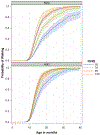Age of walking and intellectual ability in autism spectrum disorder and other neurodevelopmental disorders: a population-based study
- PMID: 33369747
- PMCID: PMC8236490
- DOI: 10.1111/jcpp.13369
Age of walking and intellectual ability in autism spectrum disorder and other neurodevelopmental disorders: a population-based study
Abstract
Background: Delayed walking is common in intellectual disability (ID) but may be less common when ID occurs with autism spectrum disorder (ASD). Previous studies examining this were limited by reliance on clinical samples and exclusion of children with severe motor deficits.
Objective: To examine in a population-based sample if age of walking is differentially related to intellectual ability in children with ASD versus other neurodevelopmental disorders (NDD).
Methods: Participants were from the nested Autism Birth Cohort Study of the Norwegian Mother, Father and Child Cohort Study (MoBa). Cox proportional hazards regression assessed if diagnosis (ASD n = 212 vs. NDD n = 354), continuous nonverbal IQ, and their interaction, were associated with continuous age of walking.
Results: The relationship between nonverbal IQ and age of walking was stronger for NDD than for ASD (Group × nonverbal IQ interaction, χ2 = 13.93, p = .0002). This interaction was characterized by a 21% decrease in the likelihood of walking onset at any given time during the observation period per 10-point decrease in nonverbal IQ (hazard ratio = 0.79, 95% CI: 0.78-0.85) in the NDD group compared to 8% (hazard ratio = 0.92, 95% CI: 0.86-0.98) in the ASD group.
Conclusions: The finding that age of walking is less strongly related to low intellectual ability in children with ASD than in children without other NDDs supports the hypothesis that ID in ASD may result from heterogeneous developmental pathways. Late walking may be a useful stratification variable in etiological research focused on ASD and other NDDs.
Keywords: Intellectual disability; MoBa; epidemiology; gross motor milestones; late walking.
© 2020 Association for Child and Adolescent Mental Health.
Conflict of interest statement
Conflicts of Interest:
Drs. Bishop and Lord have received royalties from the ADOS-2. All profits from their research are donated to charity. The other authors report no conflicts of interest.
Figures


Similar articles
-
Autism Spectrum Disorder, Intellectual Disability, and Delayed Walking.Pediatrics. 2016 Mar;137(3):e20152959. doi: 10.1542/peds.2015-2959. Epub 2016 Feb 3. Pediatrics. 2016. PMID: 26908679 Free PMC article.
-
Neonatal Thyroid Stimulating Hormone and Subsequent Diagnosis of Autism Spectrum Disorders and Intellectual Disability.Autism Res. 2020 Mar;13(3):444-455. doi: 10.1002/aur.2247. Epub 2019 Dec 10. Autism Res. 2020. PMID: 31823519
-
Prevalence and comorbidities of autism among children referred to the outpatient clinics for neurodevelopmental disorders.Pan Afr Med J. 2016 Oct 17;25:82. doi: 10.11604/pamj.2016.25.82.4151. eCollection 2016. Pan Afr Med J. 2016. PMID: 28292045 Free PMC article.
-
Association of Kawasaki disease with intellectual disability, attention deficit hyperactivity disorder, and autism spectrum disorder: a systematic review and meta-analysis.Ital J Pediatr. 2025 Feb 21;51(1):52. doi: 10.1186/s13052-025-01897-w. Ital J Pediatr. 2025. PMID: 39985017 Free PMC article.
-
Selection bias on intellectual ability in autism research: a cross-sectional review and meta-analysis.Mol Autism. 2019 Mar 1;10:9. doi: 10.1186/s13229-019-0260-x. eCollection 2019. Mol Autism. 2019. PMID: 30867896 Free PMC article.
Cited by
-
Host genetics maps to behaviour and brain structure in developmental mice.Behav Brain Funct. 2025 Jan 2;21(1):1. doi: 10.1186/s12993-024-00261-y. Behav Brain Funct. 2025. PMID: 39748372 Free PMC article.
-
A social robot connected with chatGPT to improve cognitive functioning in ASD subjects.Front Psychol. 2023 Oct 5;14:1232177. doi: 10.3389/fpsyg.2023.1232177. eCollection 2023. Front Psychol. 2023. PMID: 37868599 Free PMC article.
-
Patterns of delay in early gross motor and expressive language milestone attainment in probands with genetic conditions versus idiopathic ASD from SFARI registries.J Child Psychol Psychiatry. 2021 Nov;62(11):1297-1307. doi: 10.1111/jcpp.13492. Epub 2021 Aug 12. J Child Psychol Psychiatry. 2021. PMID: 34382689 Free PMC article.
References
-
- American Psychiatric Association. (1994). Diagnostic and statistical manual of mental disorders (4th ed.). Washington, DC.
-
- American Psychiatric Association. (2000). Diagnostic and statistical manual of mental disorders (4th ed., text rev.). Washington, DC.
-
- American Psychiatric Association. (2013). Diagnostic and Statistical Manual of Mental Disorders (5th ed.). Arlington, VA: American Psychiatric Publishing.

